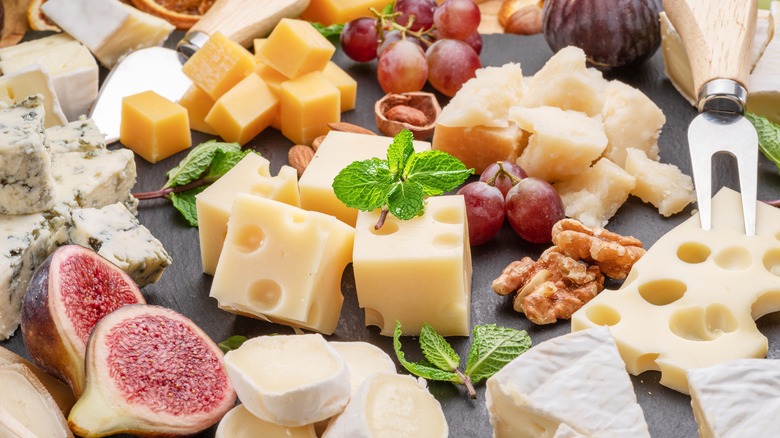The Arranging Method You Should Try For Your Next Cheese Board
Nothing pleases a crowd quite like a cheese board. A properly curated one has something for everyone, from cream to funky to nutty, accented by briny olives or sweet fruits and spreads of the jammy or spicy varieties. Because of the variety and ease of picking at this and that, they're ideal for parties but can also elevate any normal weeknight, and because they don't require any cooking, they're the easiest way to do that — you just have to know the basic tips on how to arrange the best cheese board. There are the essentials we're familiar with, like providing accoutrements with similar and contrasting flavors (such as nuts and jams) or keeping in mind that the biggest mistake to avoid is going overboard on types of cheese. But there's an approach that could improve our cheese-board skills even further: arranging the cheeses from mild to strong.
This creates a feel for your cheese board, making it more like a guided experience than just a snack to graze on. You can taste through and think about each cheese, what defines it, what you like, and what goes with it. It's hard to do this, though, if you have an intensely flavored cheese first, and then try a milder one, because the former's profile will linger and mute the latter's. That's why the order is key: Let guests start mild and work their way up, able to identify and appreciate flavors and textures.
Types of cheese to include and how to order them
For an ideal cheese board, choose about four different varieties — scale down if you're making it just for two, or up if it's a big gathering. For amounts, think 1 to 2 ounces per person if it's an appetizer, and closer to 3 or 4 ounces if it's more of a main course. When deciding on varieties, it's good to have hard, semi-soft, and soft options represented. While you want a nice range, the cheeses and accompaniments should be in the same wheelhouse. For example, if you choose a spicy cheese, keep things savory; go sweeter if you've got a cheese with fruit in it. Once you've settled on inclusions, it's time to arrange.
To get a feel for what's mild, medium, and strong, consider some of the most popular options — there are many different types of cheese, but things like cheddar, bleu, Gouda, Manchego, brie, and goat cheese are bound to show up. Soft brie is mild and buttery, so it would go first on your board. Goat cheese is stronger than brie and creamy with a slight sour tang. Follow that with subtly earthy, semi-soft Manchego and hard, nutty Gouda. Sharp cheddar would go toward the end, and funk-filled, acidic bleu cheeses would finish the board. For this arrangement, you'd ideally include little signs labeling each cheese, which helps people understand the progression.

